2001 FORD ESCORT climate control
[x] Cancel search: climate controlPage 7 of 216
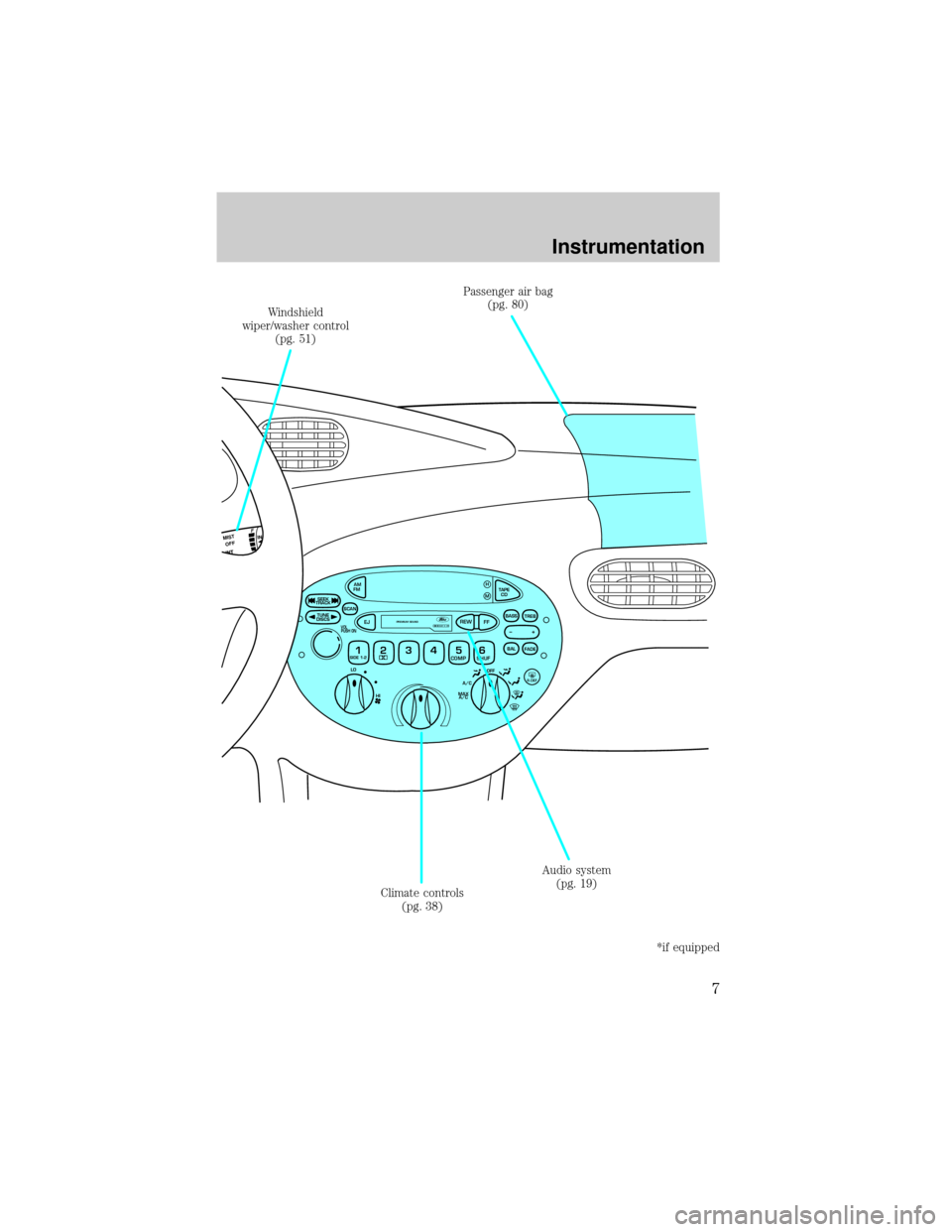
OFFR.DEFA/C
MAX
A/C HILO
TUNE
DISCS
SEEK
TRACK
SCANAM
FM
1SIDE 1-223456 COMP
SHUF EJREW
FF
PREMIUM SOUND
TAPE
CD H
M
+
BAL
FADE
BASS
TREBDOLBY B NRVOL
PUSH ON
MIST
OFFFIN
Audio system
(pg. 19) Passenger air bag
(pg. 80)
Windshield
wiper/washer control
(pg. 51)
Climate controls
(pg. 38)
*if equipped
Instrumentation
7
Page 38 of 216
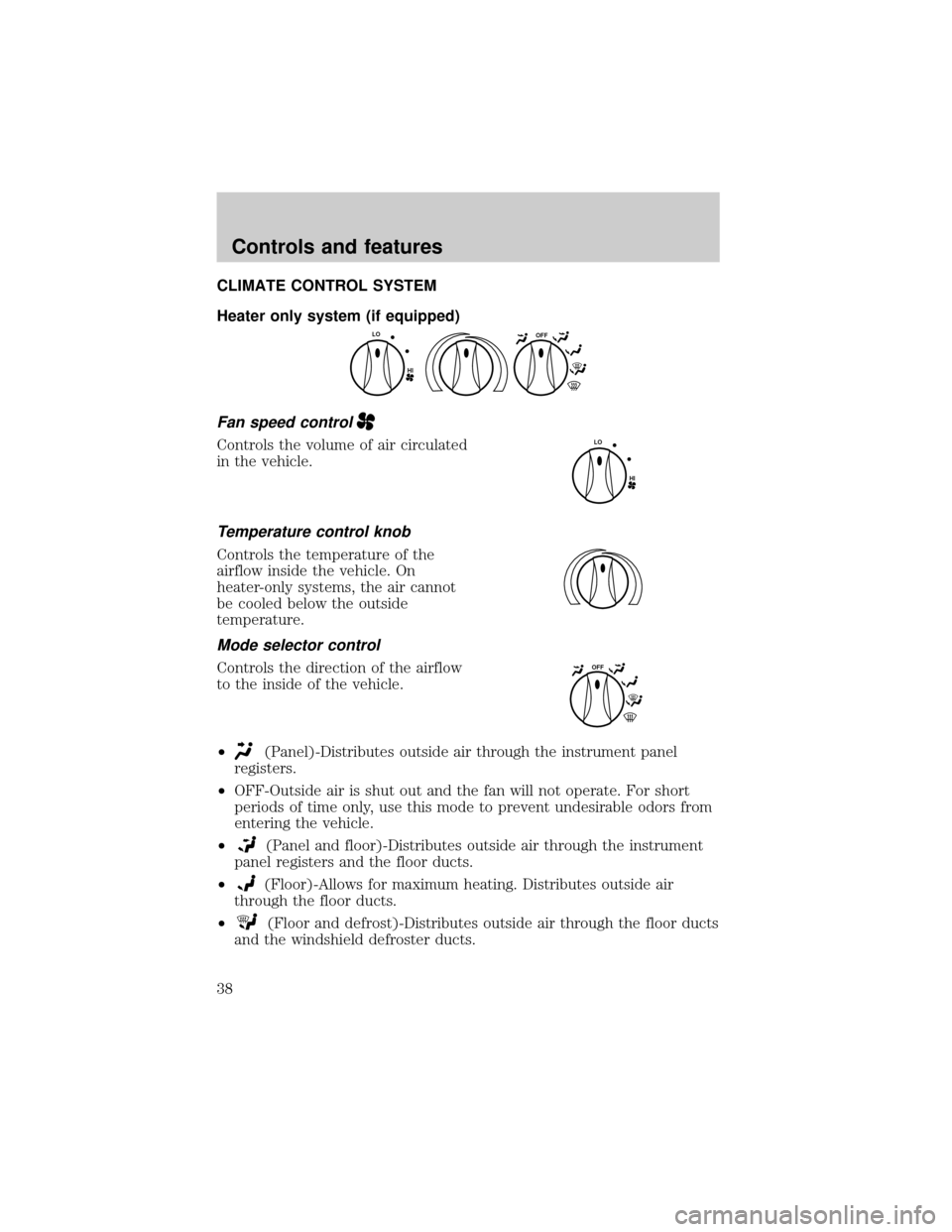
CLIMATE CONTROL SYSTEM
Heater only system (if equipped)
Fan speed control
Controls the volume of air circulated
in the vehicle.
Temperature control knob
Controls the temperature of the
airflow inside the vehicle. On
heater-only systems, the air cannot
be cooled below the outside
temperature.
Mode selector control
Controls the direction of the airflow
to the inside of the vehicle.
²
(Panel)-Distributes outside air through the instrument panel
registers.
²OFF-Outside air is shut out and the fan will not operate. For short
periods of time only, use this mode to prevent undesirable odors from
entering the vehicle.
²
(Panel and floor)-Distributes outside air through the instrument
panel registers and the floor ducts.
²
(Floor)-Allows for maximum heating. Distributes outside air
through the floor ducts.
²
(Floor and defrost)-Distributes outside air through the floor ducts
and the windshield defroster ducts.
OFF
HI
LO
HI
LO
OFF
Controls and features
38
Page 39 of 216
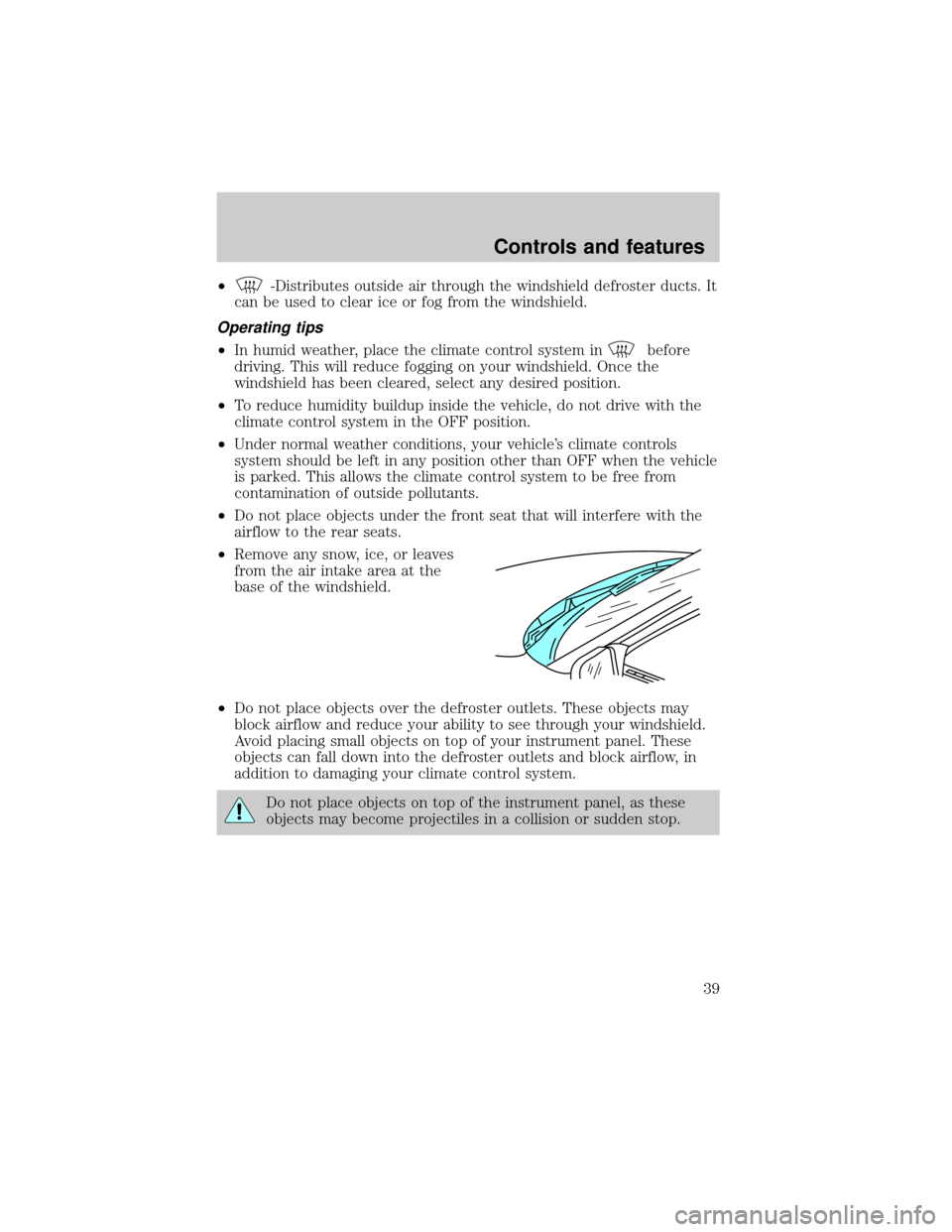
²-Distributes outside air through the windshield defroster ducts. It
can be used to clear ice or fog from the windshield.
Operating tips
²In humid weather, place the climate control system inbefore
driving. This will reduce fogging on your windshield. Once the
windshield has been cleared, select any desired position.
²To reduce humidity buildup inside the vehicle, do not drive with the
climate control system in the OFF position.
²Under normal weather conditions, your vehicle's climate controls
system should be left in any position other than OFF when the vehicle
is parked. This allows the climate control system to be free from
contamination of outside pollutants.
²Do not place objects under the front seat that will interfere with the
airflow to the rear seats.
²Remove any snow, ice, or leaves
from the air intake area at the
base of the windshield.
²Do not place objects over the defroster outlets. These objects may
block airflow and reduce your ability to see through your windshield.
Avoid placing small objects on top of your instrument panel. These
objects can fall down into the defroster outlets and block airflow, in
addition to damaging your climate control system.
Do not place objects on top of the instrument panel, as these
objects may become projectiles in a collision or sudden stop.
Controls and features
39
Page 41 of 216
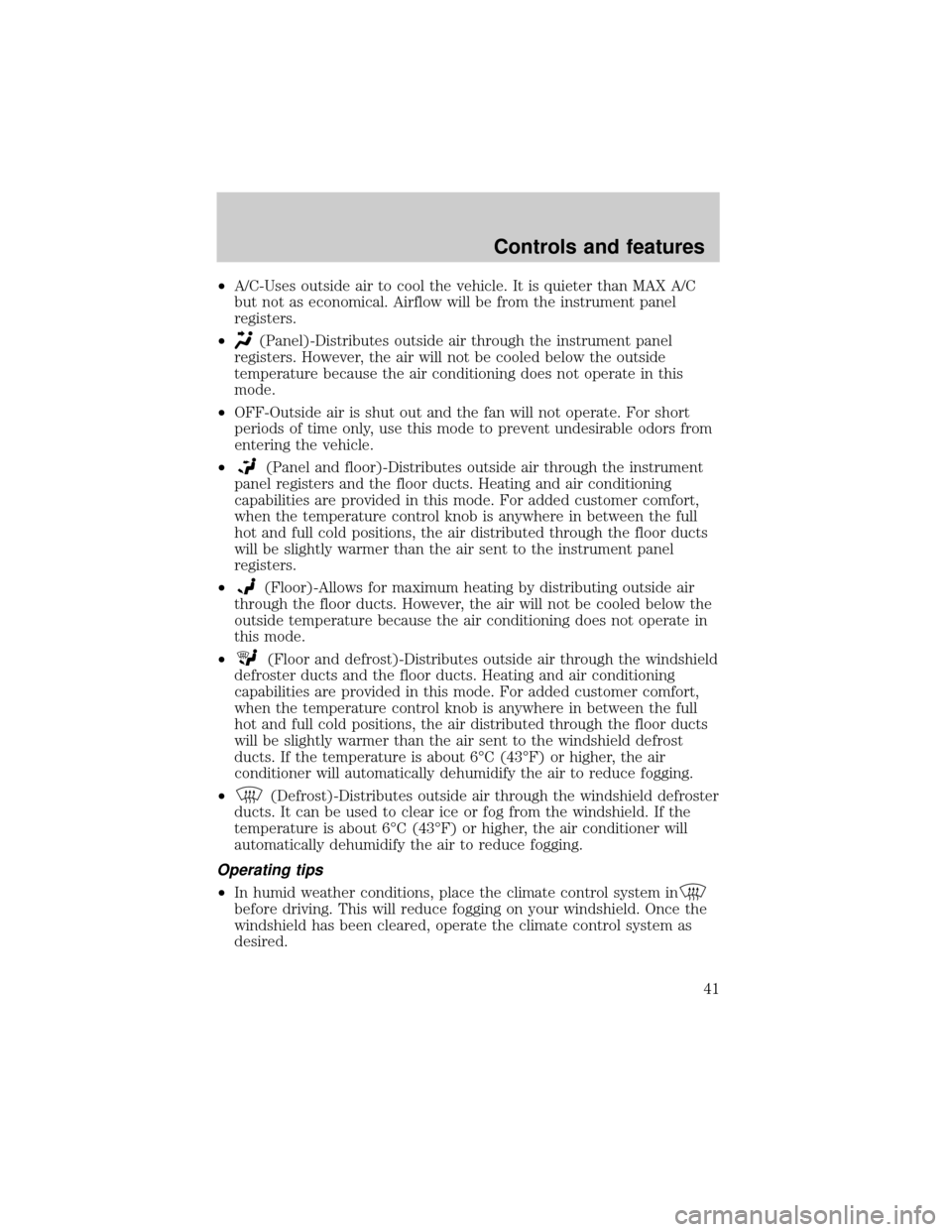
²A/C-Uses outside air to cool the vehicle. It is quieter than MAX A/C
but not as economical. Airflow will be from the instrument panel
registers.
²
(Panel)-Distributes outside air through the instrument panel
registers. However, the air will not be cooled below the outside
temperature because the air conditioning does not operate in this
mode.
²OFF-Outside air is shut out and the fan will not operate. For short
periods of time only, use this mode to prevent undesirable odors from
entering the vehicle.
²
(Panel and floor)-Distributes outside air through the instrument
panel registers and the floor ducts. Heating and air conditioning
capabilities are provided in this mode. For added customer comfort,
when the temperature control knob is anywhere in between the full
hot and full cold positions, the air distributed through the floor ducts
will be slightly warmer than the air sent to the instrument panel
registers.
²
(Floor)-Allows for maximum heating by distributing outside air
through the floor ducts. However, the air will not be cooled below the
outside temperature because the air conditioning does not operate in
this mode.
²
(Floor and defrost)-Distributes outside air through the windshield
defroster ducts and the floor ducts. Heating and air conditioning
capabilities are provided in this mode. For added customer comfort,
when the temperature control knob is anywhere in between the full
hot and full cold positions, the air distributed through the floor ducts
will be slightly warmer than the air sent to the windshield defrost
ducts. If the temperature is about 6ÉC (43ÉF) or higher, the air
conditioner will automatically dehumidify the air to reduce fogging.
²
(Defrost)-Distributes outside air through the windshield defroster
ducts. It can be used to clear ice or fog from the windshield. If the
temperature is about 6ÉC (43ÉF) or higher, the air conditioner will
automatically dehumidify the air to reduce fogging.
Operating tips
²In humid weather conditions, place the climate control system in
before driving. This will reduce fogging on your windshield. Once the
windshield has been cleared, operate the climate control system as
desired.
Controls and features
41
Page 42 of 216
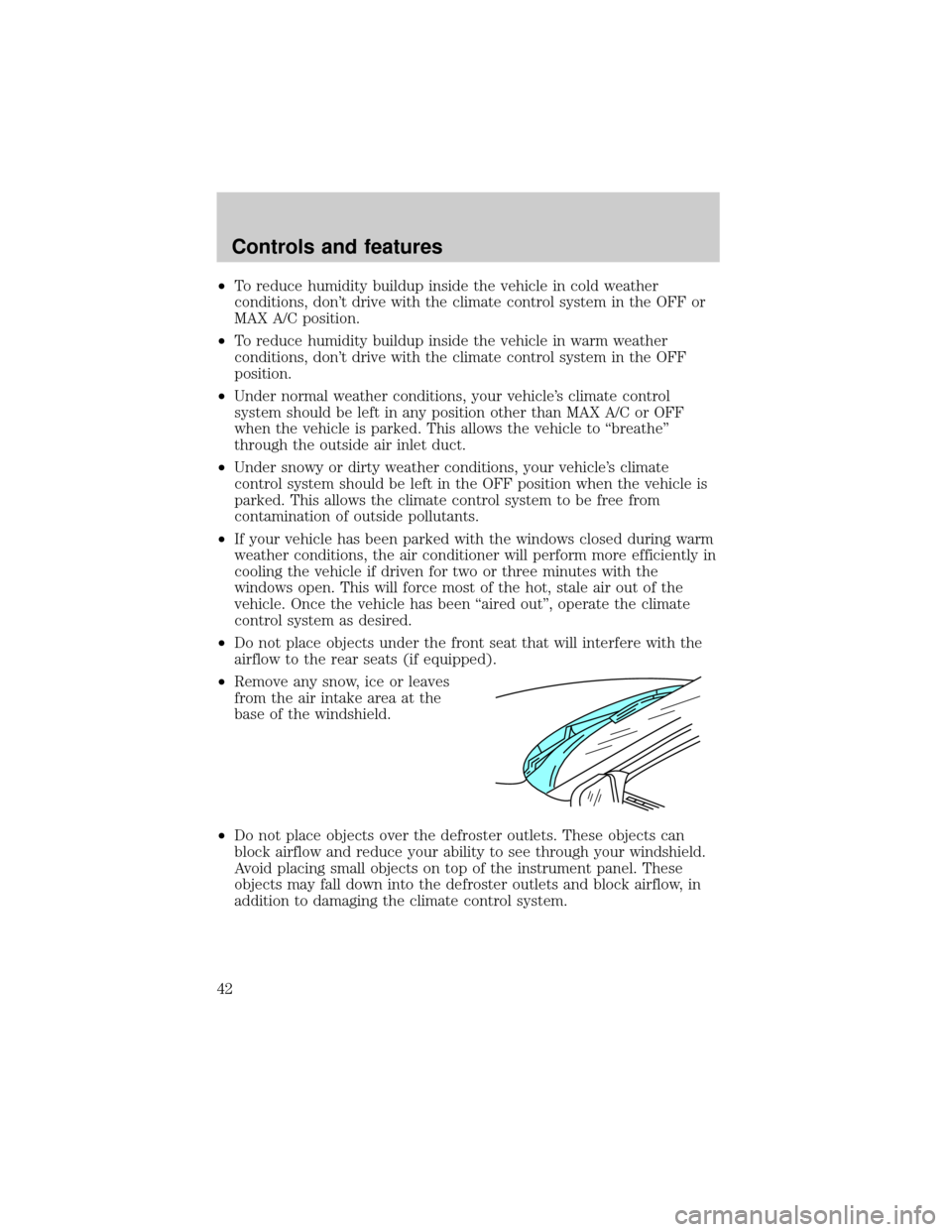
²To reduce humidity buildup inside the vehicle in cold weather
conditions, don't drive with the climate control system in the OFF or
MAX A/C position.
²To reduce humidity buildup inside the vehicle in warm weather
conditions, don't drive with the climate control system in the OFF
position.
²Under normal weather conditions, your vehicle's climate control
system should be left in any position other than MAX A/C or OFF
when the vehicle is parked. This allows the vehicle to ªbreatheº
through the outside air inlet duct.
²Under snowy or dirty weather conditions, your vehicle's climate
control system should be left in the OFF position when the vehicle is
parked. This allows the climate control system to be free from
contamination of outside pollutants.
²If your vehicle has been parked with the windows closed during warm
weather conditions, the air conditioner will perform more efficiently in
cooling the vehicle if driven for two or three minutes with the
windows open. This will force most of the hot, stale air out of the
vehicle. Once the vehicle has been ªaired outº, operate the climate
control system as desired.
²Do not place objects under the front seat that will interfere with the
airflow to the rear seats (if equipped).
²Remove any snow, ice or leaves
from the air intake area at the
base of the windshield.
²Do not place objects over the defroster outlets. These objects can
block airflow and reduce your ability to see through your windshield.
Avoid placing small objects on top of the instrument panel. These
objects may fall down into the defroster outlets and block airflow, in
addition to damaging the climate control system.
Controls and features
42
Page 162 of 216
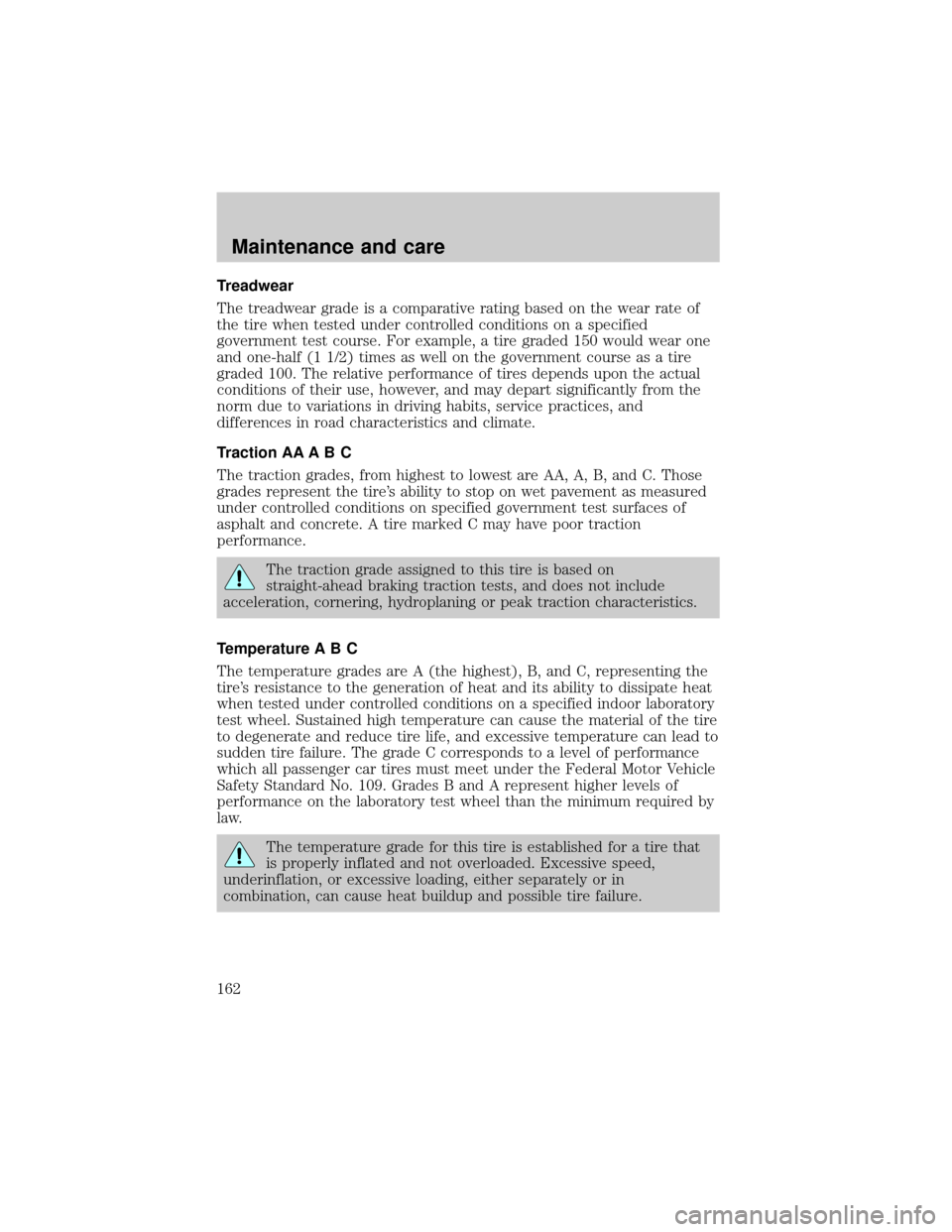
Treadwear
The treadwear grade is a comparative rating based on the wear rate of
the tire when tested under controlled conditions on a specified
government test course. For example, a tire graded 150 would wear one
and one-half (1 1/2) times as well on the government course as a tire
graded 100. The relative performance of tires depends upon the actual
conditions of their use, however, and may depart significantly from the
norm due to variations in driving habits, service practices, and
differences in road characteristics and climate.
Traction AA A B C
The traction grades, from highest to lowest are AA, A, B, and C. Those
grades represent the tire's ability to stop on wet pavement as measured
under controlled conditions on specified government test surfaces of
asphalt and concrete. A tire marked C may have poor traction
performance.
The traction grade assigned to this tire is based on
straight-ahead braking traction tests, and does not include
acceleration, cornering, hydroplaning or peak traction characteristics.
Temperature A B C
The temperature grades are A (the highest), B, and C, representing the
tire's resistance to the generation of heat and its ability to dissipate heat
when tested under controlled conditions on a specified indoor laboratory
test wheel. Sustained high temperature can cause the material of the tire
to degenerate and reduce tire life, and excessive temperature can lead to
sudden tire failure. The grade C corresponds to a level of performance
which all passenger car tires must meet under the Federal Motor Vehicle
Safety Standard No. 109. Grades B and A represent higher levels of
performance on the laboratory test wheel than the minimum required by
law.
The temperature grade for this tire is established for a tire that
is properly inflated and not overloaded. Excessive speed,
underinflation, or excessive loading, either separately or in
combination, can cause heat buildup and possible tire failure.
Maintenance and care
162
Page 210 of 216

safety belts ..............................188
washing ....................................184
waxing .....................................184
wheels ......................................185
windows ..................................188
wiper blades ............................186
woodtone trim ........................188
Climate control (see Air
conditioning or Heating) ............38
Clock ......................................25, 33
Clutch
fluid ..........................................146
operation while driving ..........106
recommended shift speeds ....108
Coolant
checking and adding ..............148
refill capacities ................152, 190
specifications ..................191±192
Cruise control (see Speed
control) ........................................46
Customer Assistance ................114
Ford accessories for your
vehicle .....................................203
Ford Extended Service
Plan ..........................................196
Getting assistance outside the
U.S. and Canada .....................202
Getting roadside assistance ...114
Getting the service you
need .........................................196
Ordering additional owner's
literature .................................206
The Dispute Settlement
Board .......................................199
Utilizing the
Mediation/Arbitration
Program ...................................202D
Daytime running lamps (see
Lamps) .........................................44
Defrost
rear window ..............................43
Dipstick
automatic transmission
fluid ..........................................154
engine oil .................................142
Doors
lubricant specifications ..........191
Driving under special
conditions
through water .........................113
E
Emergencies, roadside
jump-starting ..........................129
Emission control system ..........174
Engine ................................192±193
check engine/service engine
soon light ....................................9
cleaning ...................................186
coolant .....................................148
idle speed control ...................157
lubrication
specifications ..................191±192
refill capacities ........................190
service points ..................140±141
starting after a collision .........115
Engine block heater ...................96
Engine oil ..................................142
checking and adding ..............142
dipstick ....................................142
filter, specifications ........144, 189
recommendations ...................144
refill capacities ........................190
Index
210
Page 213 of 216

P
Panic alarm feature, remote
entry system ................................60
Parking brake ..............................99
Parts (see Motorcraft parts) ....189
Power distribution box (see
Fuses) ........................................122
Power door locks ........................54
Power steering ..........................100
fluid, checking and adding ....153
fluid, refill capacity ................190
fluid, specifications .........191±192
R
Radio ............................................19
Rear window defroster ...............43
Relays ................................117, 125
Remote entry system ...........57, 60
illuminated entry ......................62
locking/unlocking doors .....58±59
opening the trunk .....................59
panic alarm ...............................60
replacement/additional
transmitters ...............................61
replacing the batteries .............60
Roof rack ...................................113
S
Safety belts (see Safety
restraints) ........................12, 69±73
Safety defects, reporting ..........208
Safety restraints ....................69±73
belt minder ...............................75
cleaning the safety belts ..78, 188extension assembly ..................74
for adults .............................70±72
for children ...............................85
lap belt ......................................74
warning light and chime ...10, 12,
75
Safety seats for children ............86
Seat belts (see Safety
restraints) ....................................69
Seats ............................................65
child safety seats ......................86
cleaning ...........................187±188
Servicing your vehicle ..............135
Spark plugs,
specifications .............189, 192±193
Specification chart,
lubricants ...........................191±192
Speed control ..............................46
Speedometer ...............................15
Starting your vehicle ............93, 96
jump starting ..........................129
Steering wheel
tilting .........................................50
T
Tachometer .................................16
Temperature control (see
Climate control) ..........................38
Tires ...........................125, 161±163
changing ..........................125±126
checking the pressure ............163
replacing ..................................164
rotating ....................................163
snow tires and chains ............165
tire grades ...............................162
treadwear ................................162
Index
213